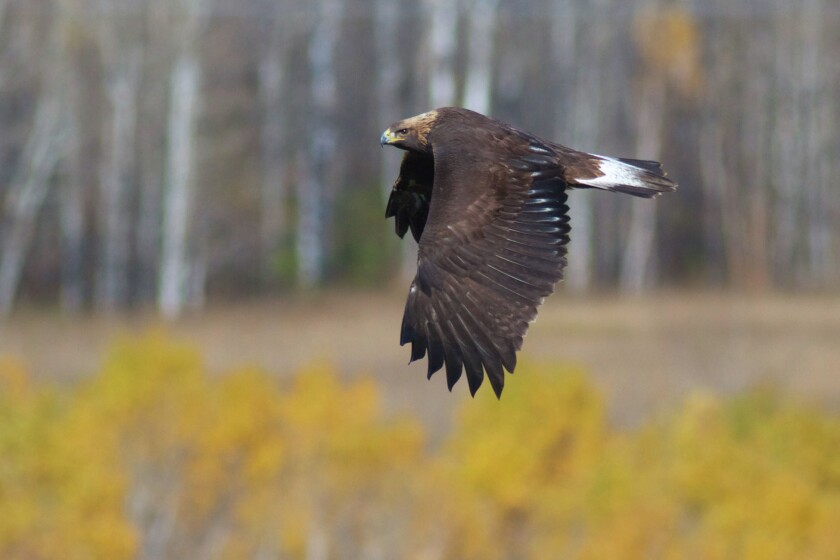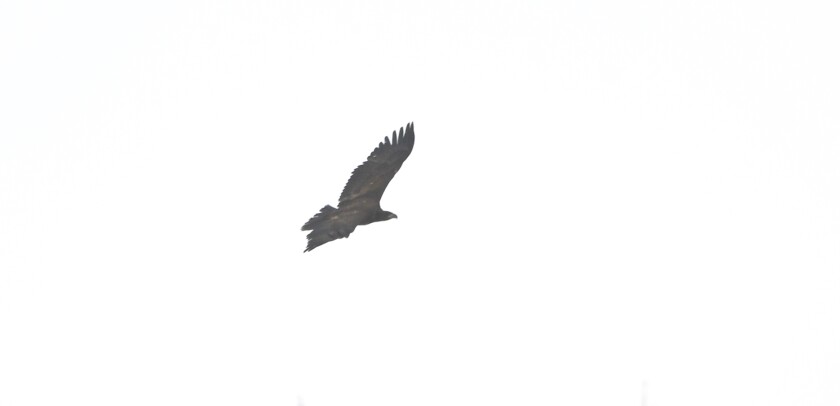Northern Great Lakes Visitor Center Ashland and Endangered Species Art Show

Contributed / Marker Sparky Stensaas
CABLE — When Ryan Brady initiated a bound raptor count at the Northern Corking Lakes Visitor Middle (NGLVC) while a educatee at Northland College in 1999, his ornithology professor, Dick Verch, had never documented a gilded eagle near Ashland.
The first bird Ryan spotted, on the very first day, showed the slightly V-shaped silhouette, pocket-size dark head and night tail of a migrating aureate eagle. Both birders were thrilled!
In the 2d year of the project, Ryan counted almost 50 gilded eagles during the spring migration season. In Duluth, the West Skyline Hawk Count spotted 41 GOEA in a unmarried day on March 17, 2022. (GOEA is the alpha code for golden eagles. Blastoff codes are abbreviations of bird names that are employed by ornithologists as shorthand. These codes are established by The Institute for Bird Populations.)
Now a conservation biologist in the Bureau of Natural Heritage Conservation, at the Wisconsin Department of Natural Resources, Ryan Brady is yet counting and researching birds in Northern Wisconsin. Ryan told me recently that part of the uptick in gold hawkeye sightings is due to an increasing population. Biologists aren't completely sure what's backside the increment.
Golden eagles were not quite as impacted by the pesticide DDT every bit other raptors, because they prey mostly on mid-sized mammals like rabbits and squirrels, which don't accrue Dichloro-diphenyl-trichloroethane to the aforementioned degree that insects, small birds and fish do. So, the banning of DDT alone can't explain their comeback.
Perhaps wildlife protection laws simply mean fewer of them are getting shot? Maybe they are adapting to wintering in our man-dominated landscapes by eating our abundance of turkeys and roadkill deer? Even so, humans (collisions with cars and structures, ingesting lead shot, etc.) are their largest source of bloodshed.
A portion of the increase in sightings may just be a result of looking more. With the proliferation of raptor counts like the one Ryan started, equally well as trail cameras capturing the eagles' presence at gut piles, people noticed more gilt eagles. They got excited, started looking more than frequently, and at present we run into a lot more than eagles!
Correct now, during their jump migration from early March through the first calendar week in May, is the best — and really the merely — chance for folks in Northwest Wisconsin to see these large birds near home.

Contributed / Larry Stone
In the winter, some golden eagles hang out in the goat prairies of the Driftless Area of Southwest Wisconsin and Northeast Iowa where they prey on wild turkeys, medium-sized mammals and feces. Others spend time in the uplands of the Mississippi River corridor, the Ozarks and even the Gulf States.
During the summer, golden eagles breed in the Black Hills and Western U.Southward., but the ones who migrate through Wisconsin are heading to the Canadian Arctic to build their nests. GOEA are besides found throughout Europe and Asia on the tundra, in boreal forests and in mountains. Simply, as confirmed past Wisconsin's recent breeding bird atlas, no golden eagles nest in Wisconsin.
On fall migration, golden eagles hit the shore of Lake Superior and follow it around to the due west. Counters at Hawk Ridge in Duluth spot dozens in October and November, simply the NGLVC is in Lake Superior'due south "shadow."
Outside of this brief window of spring migration, aureate eagles typically aren't here.
So what about the night eagles we see perched in white pines along our lakes and streams all summer long? Those are immature bald eagles, who accept four years to develop their white head and tail.
How can you tell what type of eagle y'all're seeing? Season is your showtime criteria.
Golden eagles aren't here in the summer, while baldheaded eagles of all ages are quite common.
Habitat is another inkling — golden eagles chase in the uplands and don't spend time effectually lakes and rivers like baldheaded eagles exercise. Another place you'll find bald and not gilt eagles is eating roadkill along decorated highways. Golden eagles do eat carrion, but they are more skittish and prefer to exist on the backroads.
How about size? There's a popular myth that gold eagles are bigger than bald eagles. In fact, their weights and wingspans are similar, and both species exhibit sexual dimorphism in which females are larger than males. Golden eagles have smaller heads — noticeable peculiarly in flight.
There are variations in their feathers, too. Adult bald eagles have the classic white head and tail, of course. Immature bald eagles are mostly night, with some white mottling. If there is a big patch of white, it will be in their "wingpits." In contrast, young golden eagles have white patches on their "wrists" as yous look upward at them from below. While bald eagles concord their wings flat, gilded eagle'southward wings are angled upwardly in a slight dihedral — similar to a turkey vulture — simply without the vulture's tipsy flight.
So, when is the best time to meet gilt eagles in Northwest Wisconsin? Now! Just look up!

Contributed / Emily Rock
Emily's honor-winning second book, Natural Connections: Dreaming of an Elfin Skimmer, is available to purchase at www.cablemuseum.org/books and at your local contained bookstore, as well.
For more than 50 years, the Cable Natural History Museum has served to connect you to the Northwoods. Follow us on Facebook, Instagram, YouTube, and cablemuseum.org to see what we are up to.
Source: https://www.superiortelegram.com/sports/northland-outdoors/natural-connections-golden-eagles-in-northwest-wisconsin